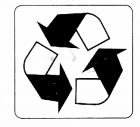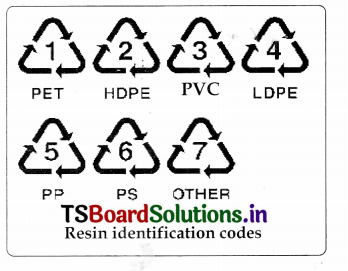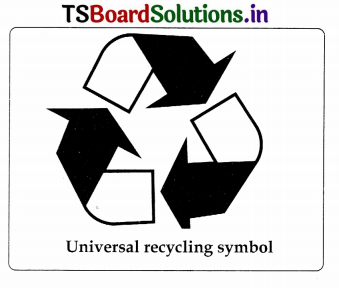These TS 8th Class Physical Science Important Questions 3rd Lesson Matter Around Us will help the students to improve their time and approach.
TS 8th Class Physical Science Important Questions 3rd Lesson Matter Around Us
Question 1.
What is nylon? Write its uses.
Answer:
Nylon:
- It was the first fully synthetic fibre. It was prepared from coal, water and air.
- Nylon fibres are strong elastic and light, lustrous and easy to wash.
- It is, used to make many items like socks, ropes, tents, toothbrushes, car seat belts, sleeping bags, curtains. etc.,
- Nylon is also used for making parachutes and ropes for rock climbing.
Question 2.
What are the drawbacks of Nylon fibre?
Answer:
Drawbacks of Nylon
- Static electricity is easily created in nylon fabrics
- It also catches fire easily.
- We should not wear nylon clothes while cooking. welding, working near a fire or using heavy machineries.
Question 3.
Observe your surrounding and make a list of articles which are made from nylon.
Answer:
Many articles that we use in our daily life are made up of nylon. Some of them are toothbrush bristles, ropes, fishing nets, tents, sarees, stockings and socks, car seat belts, sleeping bags, curtains etc.
Question 4.
Introduction of synthetic fibres in the textile industry brought revolutionary changes across the world in the dressing patterns irrespective of culture and customs. How do you appreciate this?
Answer:
Introduction of synthetic fibres in the textile industry brought revolutionary changes across the world in the dressing pattern irrespective of culture and customs. Synthetic fibres combined the world and brought unity.
I appreciate synthetic fibres not only for their roll in bringing the world colourful hut also helping in conservation of forests.
![]()
Question 5.
Why are soft drinks stored in the PET’ bottles?
Answer:
Soft drinks are carbonated. (Carbon dioxide gas is passed through them). So they should be stored in the containers in which they will not react. VET bottles will not react with soft drinks. So soft drinks are stored in PET bottles.
Question 6.
What is 4R principle?
Answer:
To avoid the negative consequences of plastic to the environment we follow the 4k principle.
R – Reduce ;
R – Recycle;
R- Reuse;
R – Recover.
Question 7.
What is Universal Recycling symbol? Explain it.
Answer:
To identify the plastic we look at the recycling icon, the chasing arrows. Inside the arrows there will be a number that identifies the polymer When the number is omitted, the symbol is known I as the Universal Recycling symbol’, indicating generic recyclable materials.

Question 8.
Why are plastics considered a threat to our environment?
Answer:
Plastics are considered a threat to our environment because
- Plastics cannot be easily decomposed.
- Plastics are non-biodegradable substances,
- When it is burnt to get rid of vaste, it gives out poisonous gases and not burn completely.
- Slow decomposition of plastics causes environmental pollution.
Question 9.
Ramesh wants to buy shirts for summer. What type of clothes would you suggest him to buy? Give your reasons.
Answer:
- I suggest Ramesh to buy cotton shirts for summer.
- The absorbing capacity of cotton fibres is more than synthetic fibres.
- In summer we have extensive sweating which must be soaked up our clothings.
- Since synthetic fabric is poor in this property we prefer cotton clothes in summer.
Question 10.
Classify the following materials into biodegradable and non-biodegradable. Paper, woollen Items, plastic bags, peels of fruits, cotton cloth, wood, tin and aluminium metal cans, computer cabinet, plastic toy.
Answer:
| Biodegradable | Non-biodegradable |
| Paper, woollen items, peels of fruits, cotton cloth, wood. | Tin, aluminium metal cans, computer cabinet, plastic toy, plastic bags. |
Question 11.
Classify following materials which can be recycled or not ? Plastic toys, electrical switches, plastic chairs, ball point pens, telephone instruments, plastic containers, cooker handles, plastic bottles, carry bags, tumblers, tooth brush, plastic chappals, plastic plates, plastic buckets
Answer:
In the above materials, some materials can be recycled and some can’t be recycled. Can be Recycled Can’t be Recycled Plastic bottles, plastic containers, Carry bags, plastic toys, ball point pens, plastic buckets, plastic chairs, telephone instruments, cooker handles, tooth brush, tumbler. electrical switches.
![]()
Question 12.
Explain following.
a) Blending
b) Bio-degradable
c) Recycling
d) De- Composition
Answer:
a) Blending: Synthetic fibre can be combined with two or more other fibres. This is called ‘Blending’. Natural and synthetic fibres are often blended for better clothing. Blending process gives us best quality of both fibres which are blended and may reduce the limitation of both fibres. Eg: Cotton and polyester blend gives us comfortable and wrinkle-free fabric.
b) Bin-degradable: A material which is easily decomposed by natural process is called bio-degradable. Eg: reels of fruits, vegetables and waste foodstuff.
c) Recycling: Th substances or materials which are broken and not useful are giving proper treatment to make them to re-use. This process is called recycling.
d) De- Composition: Certain materials can break down into smaller fragments. in the presence of water, sunlight and oxygen. These fragments get further broken down by bacteria. This is called decomposition.
Question 13.
Explain the differences between the thermoplastics and thermosetting plastics with help of a diagram explaining in terms of arrangements of monomers.

Answer:
| Thermoplastics | Thermosetting plastics |
| i. This plastic will soften when heated and harden when cooled. | This plastic when moulded into shape and allowed to cool will not change shape, when heated again they will char or burn. |
| ii. They get deformed easily on heating and can be bent easily. | They are strengthened during heating but cannot be remoulded. |
| iii. They turn into a liquid when heated and freeze to a very glassy state when cooled sufficiently. | Strong cross-links are formed during the initial moulding process. |
| iv. Polythene, PVC are examples for thermoplastics | Bakelite, melamine are examples for thermo-setting plastics |
| v. They are used in manufacturing toys, combs and containers. | They are used for making electrical appliances, handles of various utensils, kitchenware, computer and TV cabinets etc. |
Diagrams
1.

2.

3.

4.

Choose the correct answers:
Question 1.
Which of the following is natural fibre obtained from plants? ( )
A) cotton
B) ketone
C) rayon
D) wool
Answer:
A) cotton
Question 2.
Melamine is an example for ( )
A) fibre
B) monomer
C) thermoplastic
D) thermosetting plastic
Answer:
D) thermosetting plastic
![]()
Question 3.
Which of the following cannot be recycled? ( )
A) toys
B) carry bags
C) cooker handles
D) plastic chair
Answer:
C) cooker handles
Question 4.
Raw materials used for preparation of synthetic fibres are called ( )
A) jute
B) petrochemicals
C) bakelite
D) rayon
Answer:
B) petrochemicals
Question 5.
Polymers are made up of small units called ……………….. .
A) layers
B) cells
C) niolocules
D) monomers
Answer:
D) monomers
Question 6.
The strongest synthetic fibre is ………………. .( )
A) rayon
B) polyester
C) nylon
D) acrylic
Answer:
B) polyester
Question 7.
Wood pulp is used to make …………… . ( )
A) rayon
B) plastic
C) wool
D) jute
Answer:
A) rayon
Question 8.
Polymer of Glucose ……………….. . ( )
A) protein
B) fructose
C) polyster
D) cellulose
Answer:
D) cellulose
![]()
Question 9.
……………………… is a non-biodegradable.
A) Paper
B) Cotton cloth
C) Wood
D) Plastic
Answer:
D) Plastic
Question 10.
………………………. is a biodegradable ( )
A) paper
B) cotton cloth
C) wood
D) all the above
Answer:
D) all the above
Question 11.
…………………… is the other name for artificial silk. (
A) Nylon
B) Acrylic
C) Polyster
D) Rayon
Answer:
A) Nylon
Question 12.
Plastics are ……………………. conductors of electricity.
A) good
B) poor
C) either A or B
D) none
Answer:
A) good
Question 13.
fibre is used for preparing parachutes.
A) Rayon
B) Cotton
C) Nylon
D) Wool
Answer:
C) Nylon
Question 14.
Rayon is mixed with cotton to make …………………. . ( )
A) bed sheets
B) carpets
C) diapers
D) sanitary products
Answer:
A) bed sheets
Question 15.
Synthetic fibre is combined with two or more other fibres. This is called …………. .( )
A) combination
B) mixing
C) blending
D) bending
Answer:
C) blending
![]()
Question 16.
Acrylic is also called as …………………. . ( )
A) fake fur
B) fur
C) wool
D) silk
Answer:
C) wool
Question 17.
…………………….. plastics become softened on heating. ( )
A) Thermoplastic
B) Thermosetting
C) A and B
D) None
Answer:
A) Thermoplastic
Question 18.
…………………… plastics become hard on heating. ( )
A) Thermoplastic
B) Thermosetting
C)A and B
D)None
Answer:
A) Thermoplastic
Question 19.
………………… is known as father of plastic industry ( )
A) Hermann
B) Melamine
C) Backeland
D) None
Answer:
C) Backeland